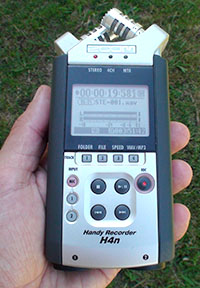Recording Ambient Audio
 The Zoom H4n Handy Recorder is an ideal device for recording ambient sound. You can use the onboard stereo mics or connect your own.
The Zoom H4n Handy Recorder is an ideal device for recording ambient sound. You can use the onboard stereo mics or connect your own.
You will need:
- Microphone(s), ideally with windscreen(s).
- Recording device, ideally digital (tape is more noisy).
- Headphones to monitor the recording.
In many cases the easiest way to record ambient sound is to use your video camera. Simply position the camera in a good spot to capture the scene's background noise, making sure you're not too close to anything that might sound noticeably louder then the rest of the background. External mics are usually better than the camera's onboard mic.
Which Microphone to use?
Any good quality, reasonably sensitive mic is sufficient. In most cases a non-directional condenser would be a good choice. Avoid noise canceling mics. Directional mics such as shotguns can be used if you specifically need directionality, or they can be used in a pair for stereo sound (see below). If you only have one shotgun, give special consideration to mic placement to avoid picking up one part of the soundscape at the expense of others.
These mics/brands are often recommended for ambient sound recording:
- Shure VP88
- Rode NT4
- DPA Microphones
- Schoeps
- Neumann
Recording Level
You don't have to record the audio at the same level that will be used in the final product—you can adjust the level during post production. So the goal is roughly the same as all audio recording; that is, record at a high enough level to get a good signal while giving yourself enough headroom to avoid distortion. Ambient audio levels will usually be lower than other types of audio.
Make sure you set the level manually—don't use automatic gain control. Auto-gain can increase noise and make the recording level fluctuate.
Mono, Stereo, 5.1
It's a good idea to record at least 2 tracks (stereo) or even 6 tracks (5.1). Multiple tracks can be mixed down later if you don't need them but you can't really create good stereo if you didn't record separate tracks to start with. In most cases stereo is all you really need—don't worry about 5.1 unless you have a specific need for it.
Stereo mics can be spaced a few meters (about 8') apart or used in the XY configuration. Recording in a wide stereo setting provides maximum flexibility as the separation can be reduced if necessary in post production.
Other Tips
- Record more ambient audio than you think you'll need.
- Sometimes it's a good idea to get some close-up audio recordings. For example, in a tropical forest you could get a combination of general ambient sounds with "close-ups" of particular noises (insect buzzing, birdsong, etc).
- You don't have to use the audio track exactly as recorded—in post production, try tweaking the sound by playing with the EQ etc.